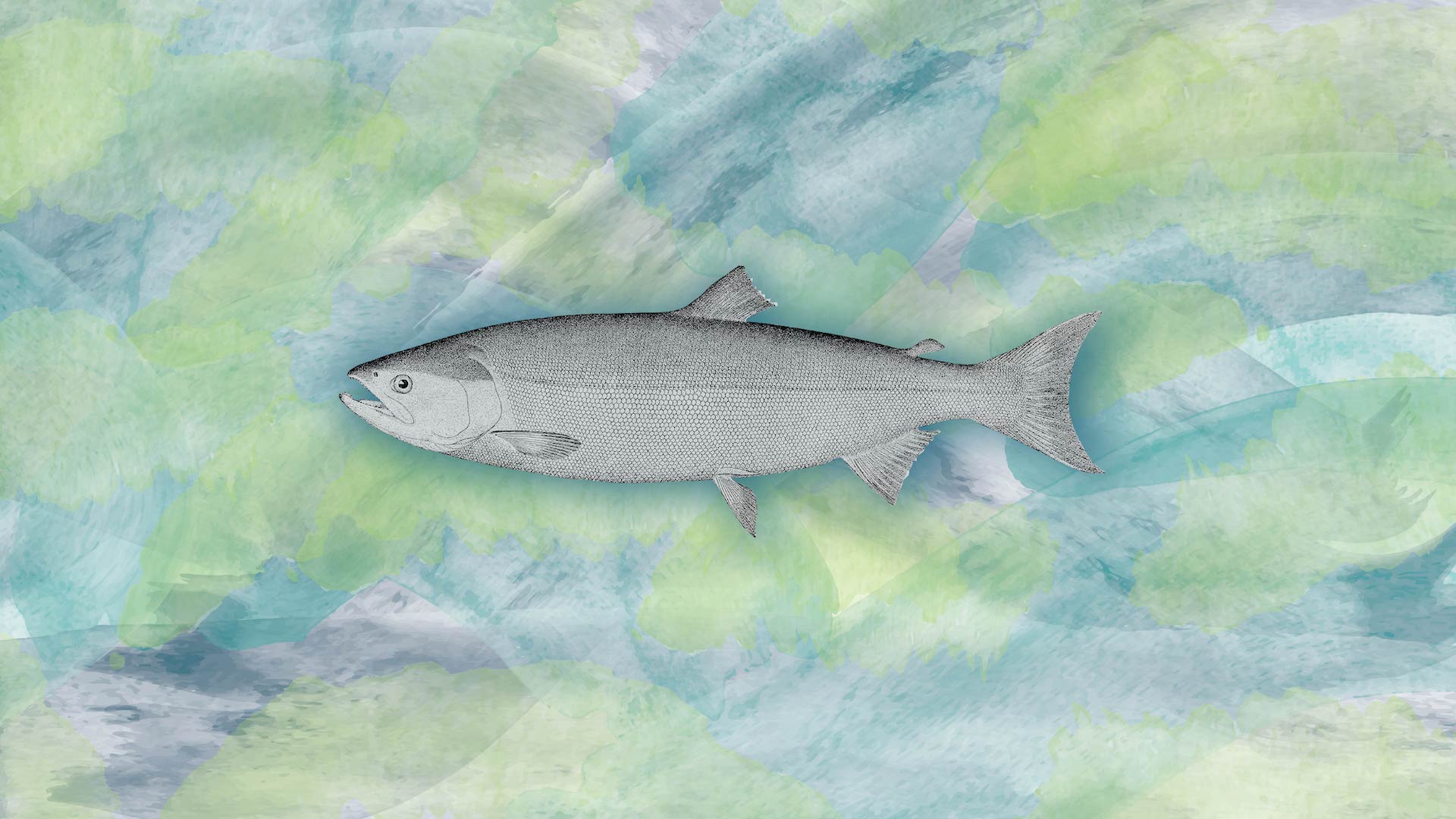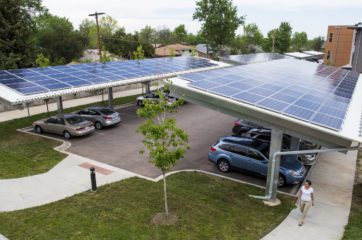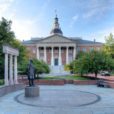Like many Indigenous people around the world, the people of the Quinault Indian Nation (QIN) have always been intrinsically connected to the natural environment. Stretching from the Pacific Ocean to the Olympic Mountains, the reservation depends upon natural resources as their primary source of income — salmon and steelhead fishing, as well as an abundant timber supply, make up the backbone of the Quinault economy.
Now, climate change is threatening the security of the Quinault community, as their main village undergoes regular flooding and the salmon population disappears. But tribal members are determined to protect themselves and their land.
Fawn Sharp, who is currently serving her fifth term as President of the Nation, has committed her life to fighting the threat of climate change and protecting her people. Last October, President Sharp was also elected as the President of the National Congress of American Indians (NCAI) — the organization advocating for the interests of all sovereign American Indian and Alaskan Native nations and serving as the unified voice of U.S. tribal governments — where she made climate change the central issue in her platform.
In her own community, this has led President Sharp to propose placing a carbon pollution fee upon businesses operating on Quinault lands, to hold polluters accountable and finance climate adaptation measures for her people. The revenue from the price would go towards a plan to relocate the village of Taholah, home to over 700 Quinault residents, which is increasingly at risk to frequent storms and flooding.
“Those who are directly responsible for causing the damage should be paying for generations of exploitation,” President Sharp said.
A disrupted fishing industry
While progressing in her leadership roles, President Sharp has kept a steadfast focus on the environment. The Intergovernmental Panel on Climate Change finds that the communities most vulnerable to climate change are those located in coastal and river-floodplains, with economies dependent on climate-sensitive resources, and those located in areas at risk from extreme weather events. Most tribal nations fit into at least one, if not all three, of these categories. The reliance on salmon and trout fishing is particularly common among indigenous communities in the U.S., and the Environmental Protection Agency predicts that in the next 40 to 80 years, half of the salmon and trout in this country will be destroyed by climate change.
Fishing remains a key part of not only the Quinault economy, but also community. Almost half of the reservation’s population directly depends on fishing for survival — particularly, the sockeye salmon, locally called the blueback, which is unique to the region.
But now, fishing has all but disappeared. For centuries, the Quinault river system has been dependent on glacial runoff from the Olympic mountains. This changed nine years ago when the glacier finally melted because of warming temperatures, causing a massive release of sediment into the watershed that led to instability in the river channel, which makes it increasingly difficult for salmon to spawn. Salmon populations are also dependent on the cold water flows coming from the glacier, especially in the summertime, and without them, the riverbed dries up leaving little space for traditional salmon habitats. The disappearance of the salmon is exacerbated by warming ocean temperatures, ocean acidification, and changing currents and fish migration patterns, which altogether have led to a sharp decline in the amount of salmon available for the Quinault to fish. In 2015, this meant that almost all the salmon fisheries had to be closed.
“The sockeye salmon are our main source of the fish that we eat, and due to the lack of them surviving in the ocean, we haven’t had a fishery in the last three to four years. We’re heading for disaster,” Councilman John Bryson Jr. told me over the phone this week. Experts estimate that in the past, blueback numbers in the Quinault watershed have been in the millions, and the Quinault Fisheries Department determined that at least 25,000 are needed to spawn. But in 2007, it was estimated by the National Parks Service that there were only 5,000 blueback returning each year.
Fishing risks are worsened by legalities associated with treaty rights that the Quinault reserved in the Treaty of Olympia with the U.S. government (the treaty is also known as the Treaty of Quinault, 1856), which has resulted in a specific area within the ocean, defined with a legal description, that the Quinault are allowed to fish within. The Tribes of the Pacific Northwest are one of the very few Indigenous nations in the world to have treaty rights over the ocean.
“What we get as part of that legal definition is a defined box in the ocean. So we have a box we can fish in, and that’s it. That’s the only place that Quinault can exercise their treaty rights in the entire ocean,” Joe Shumacker, the Marine Resources Scientist for the QIN, told me in an interview. This heavily complicates the issue of fishing — as the fish migration patterns change and they no longer appear in their regular locations, the Quinault cannot move their fishing industry to find them again.
“Of course, that translates to the livelihoods of our fishermen, and the economy of our fishing industry,” Larry Gilbertson, Senior Scientist for the Quinault Fisheries Department, added.
A thousand-year old culture under siege
There is also an immense cultural loss that comes with the diminishing salmon. The sockeye salmon play an integral role in Quinault culture and tradition, and are a necessary part of the community.
“As long as I can remember, attending funerals, weddings, birthday parties, I grew up with cooked blueback on a cedar stick, just as my family has for thousands of years,” President Sharp said.
Every year at the start of the fishing season, the Quianult mark the occasion with their First Salmon ceremony, a tradition shared by many tribal nations in the Pacific Northwest that spans centuries.
I also spoke with Justine James, QIN Cultural Resource Specialist and tribal member, who said, “in the past, we’ve done huge First Salmon ceremonies and because there are communal fishing sites, the salmon would be passed out to the elders first and then throughout the rest of the community,”
“We haven’t been able to conduct the First Salmon ceremony the last couple of years because the season was closed down before it even opened, so none of the fishermen were allowed to set their nets out,” James added.
While the blueback salmon are certainly an economic staple for the Quinault, and their disappearance is a massive monetary loss, the fish are also intrinsically tied into the culture, tradition, and lifestyles of the Nation. In this way, the disappearance of the blueback is harming the very fabric of the Quinault community.
A village soon to be submerged
On top of the threat the climate crisis poses for the fishing industry, flooding risks caused by climate change also severely threaten the habitability of the community. The largest village in the reservation, Taholah Village, is especially endangered. Waves from minor storms constantly threaten the sea wall surrounding the village, and on multiple occasions, “residents could canoe between First Street and the police station” due to the flooding. The flooding has recently worsened as storms have become more intense and sea-level rise has expanded. According to Mark Mobbs, Environmental Scientist for Quinault Fisheries, there have been noticeable increases in flood height over the past decade.
“You go down to the end of the road on Quinault street, and you look out into the ocean — the ocean is higher than the street you’re standing on. The street’s been elevated by 10 feet of gravel since 1930, so that shows you. The water’s coming up, and the land is being eroded. It’s pretty scary for the people that live down there,” said James on this matter.
In 2017, the threat of flooding prompted the Quinault to release a plan to relocate the approximately 700 residents who live and work in Taholah, which will cost around $150 million.
But many of the residents of Taholah Village don’t want to move. Taholah has been their home for centuries, and moving means giving up their homes, and the memories and traditions that are ingrained within them.
“My father’s house is only a block and a half from the ocean, and he says, ‘I ain’t moving, this is my home, I’ve been here, and I’m going to stay here no matter what.’ So even if there was housing available some of the people will not move,” James told me, “I doubt I would move if I was still there. That was one of the most soothing things that I ever had, was to just open my window and listen to the roar of the ocean.”
The starkest reality of climate change is that the countries least responsible for emitting greenhouse gases are the ones facing the worst climate impacts. One such state is the island nation of Kiribati, located in the Pacific Ocean, and projected to become increasingly uninhabitable over the next 50 years. We spoke to Janice Cantieri, an environmental journalist and Fulbright National Geographic storyteller, about her work in Kiribati, the importance of storytelling in climate change communication, and local adaptation and innovation.
Chrissy Winn, a member of the Quinault who owns a family-run seafood business, is also troubled with the prospect of relocation. “I have a friend whose Indian name means, ‘Where the bend of the river meets the cool creek off the mountain.’ If he moves away, two generations from now people might remember that name, but they’re not going to know where the bend in that river is or that creek. And that’s about place. We can’t just leave. It’s unfathomable,” she said.
A crisis worsened by the Federal Government
In a similar vein to the issue of disappearing salmon, the crisis of Taholah Village is exacerbated by the federal government, which has consistently neglected the needs of the Quinault and other tribal nations.
Although the Quinault have an immediate need to relocate the people living in Taholah, the Quinault are place-based, which means that they are only allowed to live on the land that was decided upon in the Dawes Act, a federal law written in 1887 that “fragmented the Quinault Reservation into many small individually owned allotments.”
“The Quinault cannot move and add a treaty right somewhere else — it only exists here. It’s imperative that they defend what they have so that they maintain something for future generations,” Shumacker told me.
But the piece of land that the nation needs to relocate itself to higher ground is technically not owned by the Quinault Indian Nation, according to the Dawes Act, as these lands were allotted to individuals. The Quinault have faced challenges with acquiring the land needed. And even once the land is acquired, many Quinault members may not be able to afford the move.
“Most tribal members don’t have the resources to build a new house, about 25% of the community is trailers, because they just don’t have the money to build,” James told me. The federal government has failed to give adequate funding to the Quinault, despite the state of emergency that President Sharp has called.
“Probably the biggest hindrance right now is funding, we’ve had a very difficult time trying to get funding from the U.S. government, and no money has come in so far,” said Dave Bingaman, Director of the QIN Division of Natural Resources.
A struggle for solutions — the Washington State carbon fee
For many years, President Sharp has understood how threatening climate change is to her community, and has fought hard for policies outside of the Nation to address this.
She came very close to realizing this goal in 2018, when Washington State almost passed Ballot Initiative I-1631. This initiative would have placed a $15 per ton fee on carbon emitted in the state, with 10% of the revenue dedicated towards climate mitigation projects in tribal communities. President Sharp played an integral role in creating this ballot initiative, working with the Climate Alliance for Jobs and Clean Energy, who authored it, to make sure that the carbon fee would be equitable and just. She also launched The First American Project during the campaign for the initiative, which brought together tribal leaders from across the state in support of I-1631.
“There were so many people who helped out and stepped up, and we’re really proud of what we did,” said Councilman Bryson.
Unfortunately, the Ballot Initiative did not pass, despite widespread public support, largely due to the concerted efforts of the fossil fuel industry. Big corporations such as Chevron and BP donated over $31 million dollars in campaign funds against the measure — the most an opposition campaign in Washington State had ever spent.
“There is so much behind trying to keep carbon emissions out of the public discourse that the average citizen understands it’s a problem. But there are just so many corporate and special interests that keep us from adopting a good policy,” said President Sharp. Many smart climate policies face this issue — although there is often widespread support and scientific backing for a policy, the money and influence of large corporations prohibits it from implementation.
But this did not stop President Sharp from fighting for the survival of her people and her community. She recently announced that she plans to impose her own carbon fee upon businesses operating on Quinault land, which she hopes will not only decrease pollution in the area, but will also be able to provide funding for the relocation of the Quinault living in areas most vulnerable to flooding, as well as an economic transition for those who have lost their jobs due to the disappearing salmon. Although the COVID crisis has pushed back implementation processes, for now the fee is voluntary, and will likely be further discussed by the Quinault Tribal Council in the near future.
Adapting to climate change
There are certainly solutions that will protect the Quinault from some of these climate-related issues, and the Nation has begun working on many of them, primarily by relocating their historic village and diversifying their economy. But doing so comes with massive cultural consequences, and could result in the destruction of the Quinault way of life.
“Closing down fisheries will take away a cultural right,” Bingaman told me.
Still, even as Taholah residents move out of their family homes and change their occupations, they are still fighting to keep traditions close. “As fishing has dwindled, a lot of the fishermen have become part time, because it is culturally ingrained in many of these members that they have to go out and exercise those cultural rights and those historic activities — just to do it. They don’t make as much money as they do in their other jobs but they just have to do it,” Bingaman said.
There are also massive restoration projects taking place in order to bring the blueback salmon back to their natural habitat. The approach is three-tiered: it includes lake fertilization, river restoration, and a blueback salmon supplementation program.
“[We are] creating engineered log jams, and they’ve got 15 of them installed thus far. It’s really helping out in stabilizing the environment and we are starting to see a lot more blueback coming back into that area,” James told me.
“We are seeing fish utilize these habitats right away, so that gives me some optimism, that if we’re able to increase those areas of new habitat and continue those restoration efforts throughout the reach, that we’re going to start seeing a response,” said Bill Armstrong, Habitat Scientist for the QIN.
Although the road to recovery may be long and difficult, the Quinault are not going to give up. Someday, with a combination of restoration efforts and good policy, there is hope that the blueback population will be restored, and that traditions such as the First Salmon ceremony will not be lost. But a lot of that process is not up to the Quinault. While the Quinault are massively affected by climate change, more than many other communities in the US, they barely contribute to the problem and have extremely low emissions rates. It is the emissions-intensive economy that the rest of Americans, and a large part of the world, rely on that have so disproportionately impacted the Quinault and many other Indigenous nations.
We have a lot to learn, and the knowledge needed in order to successfully restore so many of our forests and natural lands, and well as the knowledge on how to steward them sustainably, lies in ancient indigenous wisdom. It is therefore critical that we not only support the need for adaptation and restoration of the environment within reservations, but ensure the cultural protection of Indigenous nations in our country.
So what can you do?
Register to vote, and vote for the climate. Join our State Carbon Pricing Network, and search for other climate advocacy opportunities. Do what you can to make an impact, and understand that the climate crisis has no boundaries — the actions of polluting industries all across the globe are impacting the Quinault, and many other communities like theirs, and we have to stand up to the interests of fossil fuel industries if we are to make real changes.









